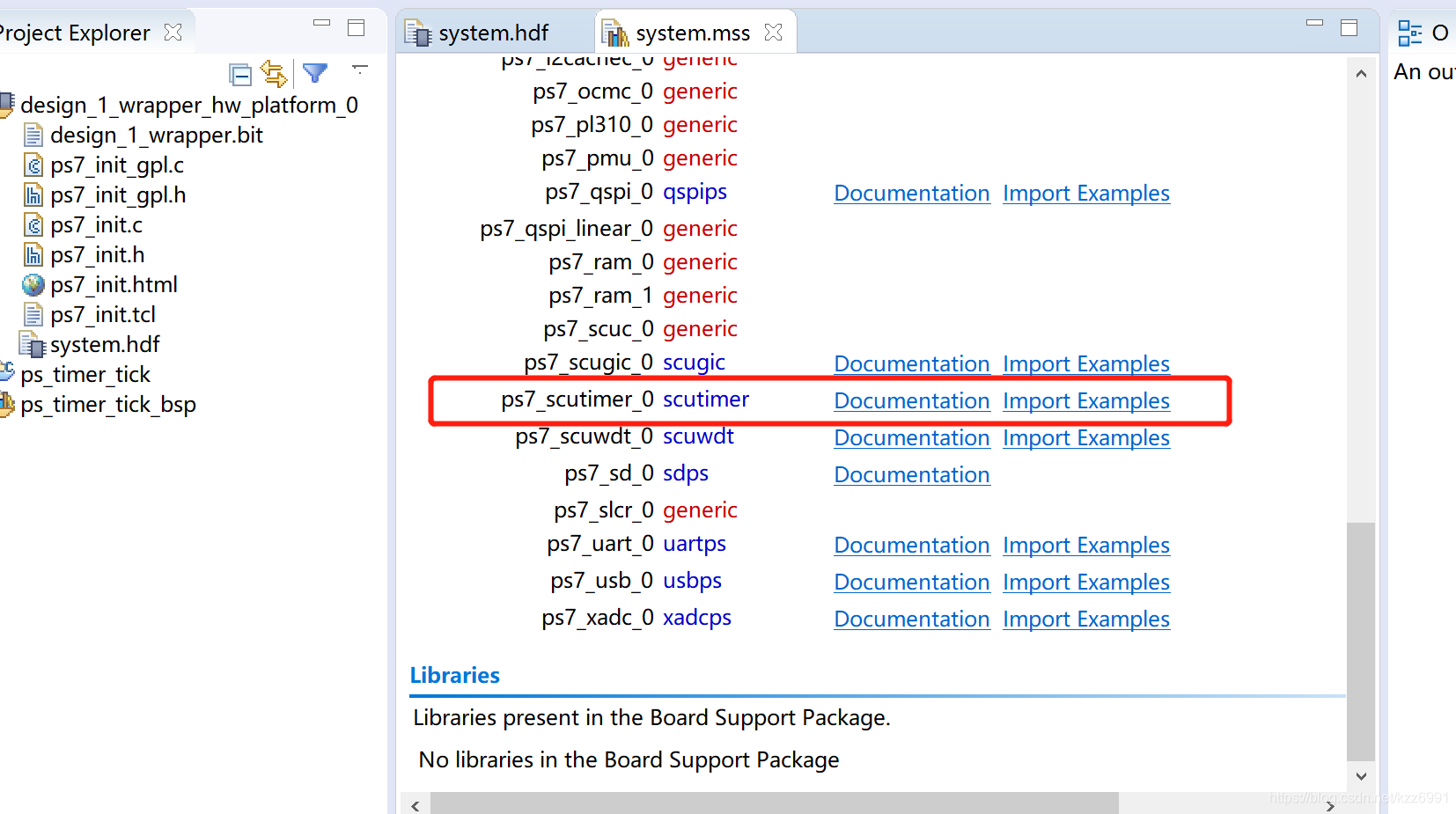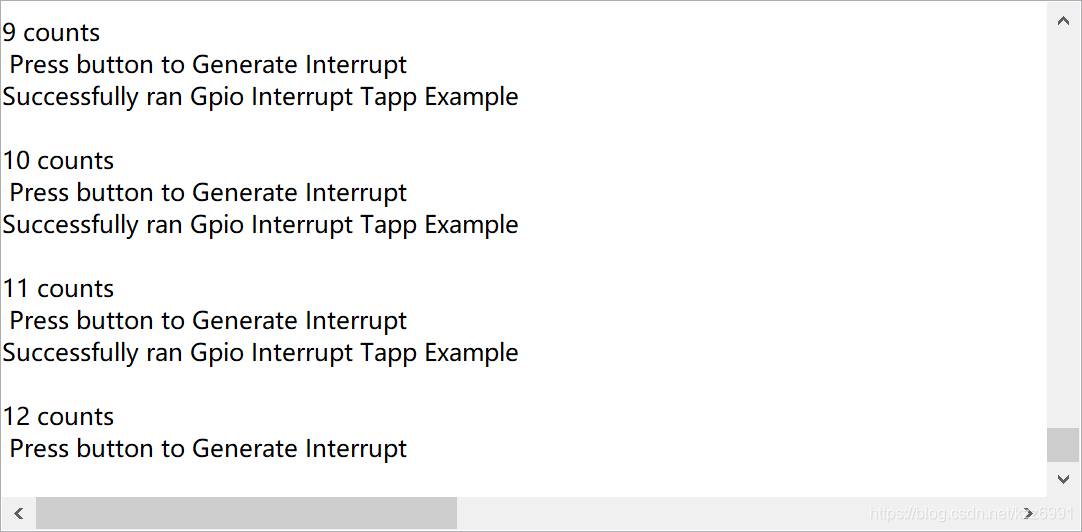中断
对于一个嵌入式系统而言,实时性是很重要的东西,而保证cpu对某个时间的实时响应往往就要依靠中断。
用单片机的时候经常提到中断这个概念,一般来讲,其实就是当某个事件发生时,会将一个信号送到cpu的中断引脚,而cpu接到这个中断信号后就立刻放下手头的事情,去先搞定这个不速之客,所以脚中断嘛。
之前那个led闪灯就随便查询按键就会有不灵的情况,如果有中断就会好很多了。
PS的定时器中断
我这里图省事直接把之前的ps端led工程另存为了新工程ps_timertick开始操作,也可以重头再来。
PS中的定时器由于不需要管脚输出,就不配置管脚了,直接启动SDK,里面这些历史残余统统删除!!!

然后重新launch SDK,欸嘿,新的硬件平台信息出现了,这次还是新建一个application工程,就叫ps_timer_tick吧,还用默认的hello world
如何用定时器
那定时器咋用咧

我们可以找到一个scutimer,后面有examples,打开看看,第一个就是中断例程,intr就是interrupt的简写。

咱们可以参考这个来写中断的程序
代码的编写
实现目标: 每秒让灯切换一次状态,并且从串口发送一个秒数如何???
就直接在例程上进行魔改吧,反正天下代码一大抄,首先把计数器最大值修改为cpu频率的一半,因为计数器时钟频率是cpu频率的一半,所以可以实现1秒中断一次。
#define TIMER_LOAD_VALUE (XPAR_PS7_CORTEXA9_0_CPU_CLK_FREQ_HZ/2-1)
从定义可以查得cpu频率是
#define XPAR_PS7_CORTEXA9_0_CPU_CLK_FREQ_HZ 650000000
然后来到函数
int ScuTimerIntrExample(XScuGic *IntcInstancePtr, XScuTimer * TimerInstancePtr,
u16 TimerDeviceId, u16 TimerIntrId)
找到计数次数
/*
* If it has expired a number of times, then stop the timer
* counter and stop this example.
*/
if (TimerExpired == 3) {
XScuTimer_Stop(TimerInstancePtr);
break;
}
由注释可知当达到这个次数的时候就停止这个example了,咱们给它改长点,比如一分钟,60次。
接下来找到中断处理函数
static void TimerIntrHandler(void *CallBackRef)
{
XScuTimer *TimerInstancePtr = (XScuTimer *) CallBackRef;
/*
* Check if the timer counter has expired, checking is not necessary
* since that's the reason this function is executed, this just shows
* how the callback reference can be used as a pointer to the instance
* of the timer counter that expired, increment a shared variable so
* the main thread of execution can see the timer expired.
*/
if (XScuTimer_IsExpired(TimerInstancePtr)) {
XScuTimer_ClearInterruptStatus(TimerInstancePtr);
TimerExpired++;
if (TimerExpired == 3) {
XScuTimer_DisableAutoReload(TimerInstancePtr);
}
}
}
修改if (TimerExpired == 3)的3为60
在其中的 XScuTimer_ClearInterruptStatus(TimerInstancePtr);后面添加打印时间的语句
printf("%d Second\n\r",TimerExpired);
除此之外还应该添加个变灯不是,补充缺失的头文件
#include "xil_io.h"
#include "xgpio.h"
#include <stdio.h>
然后在处理函数中添加之前的led开灯程序
接下来和之前一样烧写程序。
串口不断有信息传来

灯也不断闪烁。

PL的按键中断
直接就在刚才的平台改吧,回来添加一个AXI_GPIO让它连接btns,双击把gpio设置成btns,然后自动布线
打开新创建的AXI_GPIO,使能中断
在zynq中的中断有

因此我们接下来打开Zynq处理器,使能IRQ中断。

将刚刚生成的两个中断端口连接,Block design就完成了,又开始了漫长的bit stream生成。
然后依然是到SDK中
我们新建一个application 工程,就叫key_intr吧
我们导入axi0的intr例程,和之前一样。
(噢对因为例程不想改,所以我用按键用的是axi0😂)
然后添加led的相关代码,以及让他串口还返回按下的次数
烧写程序,有

灯有每次按键改变状态。
缺点就是没有防抖。。。。所以emmm哈哈哈哈哈
修改后的完整代码
/******************************************************************************
*
* Copyright (C) 2002 - 2015 Xilinx, Inc. All rights reserved.
*
* Permission is hereby granted, free of charge, to any person obtaining a copy
* of this software and associated documentation files (the "Software"), to deal
* in the Software without restriction, including without limitation the rights
* to use, copy, modify, merge, publish, distribute, sublicense, and/or sell
* copies of the Software, and to permit persons to whom the Software is
* furnished to do so, subject to the following conditions:
*
* The above copyright notice and this permission notice shall be included in
* all copies or substantial portions of the Software.
*
* THE SOFTWARE IS PROVIDED "AS IS", WITHOUT WARRANTY OF ANY KIND, EXPRESS OR
* IMPLIED, INCLUDING BUT NOT LIMITED TO THE WARRANTIES OF MERCHANTABILITY,
* FITNESS FOR A PARTICULAR PURPOSE AND NONINFRINGEMENT. IN NO EVENT SHALL
* XILINX BE LIABLE FOR ANY CLAIM, DAMAGES OR OTHER LIABILITY,
* WHETHER IN AN ACTION OF CONTRACT, TORT OR OTHERWISE, ARISING FROM, OUT OF
* OR IN CONNECTION WITH THE SOFTWARE OR THE USE OR OTHER DEALINGS IN THE
* SOFTWARE.
*
* Except as contained in this notice, the name of the Xilinx shall not be used
* in advertising or otherwise to promote the sale, use or other dealings in
* this Software without prior written authorization from Xilinx.
*
******************************************************************************/
/*****************************************************************************/
/**
* @file xgpio_intr_tapp_example.c
*
* This file contains a design example using the GPIO driver (XGpio) in an
* interrupt driven mode of operation. This example does assume that there is
* an interrupt controller in the hardware system and the GPIO device is
* connected to the interrupt controller.
*
* This file is used in the Peripheral Tests Application in SDK to include a
* simplified test for gpio interrupts.
* The buttons and LEDs are on 2 separate channels of the GPIO so that interrupts
* are not caused when the LEDs are turned on and off.
*
* <pre>
* MODIFICATION HISTORY:
*
* Ver Who Date Changes
* ----- ---- -------- -------------------------------------------------------
* 2.01a sn 05/09/06 Modified to be used by TestAppGen to include test for
* interrupts.
* 3.00a ktn 11/21/09 Updated to use HAL Processor APIs and minor changes
* as per coding guidelines.
* 3.00a sdm 02/16/11 Updated to support ARM Generic Interrupt Controller
* 4.1 lks 11/18/15 Updated to use canonical xparameters and
* clean up of the comments and code for CR 900381
* 4.3 ms 01/23/17 Modified xil_printf statement in main function to
* ensure that "Successfully ran" and "Failed" strings
* are available in all examples. This is a fix for
* CR-965028.
*
*</pre>
*
******************************************************************************/
/***************************** Include Files *********************************/
#include "xparameters.h"
#include "xgpio.h"
#include "xil_exception.h"
#include "xil_io.h"
#include "xgpio.h"
#ifdef XPAR_INTC_0_DEVICE_ID
#include "xintc.h"
#include <stdio.h>
#else
#include "xscugic.h"
#include "xil_printf.h"
#endif
/************************** Constant Definitions *****************************/
#ifndef TESTAPP_GEN
/*
* The following constants map to the XPAR parameters created in the
* xparameters.h file. They are defined here such that a user can easily
* change all the needed parameters in one place.
*/
#define GPIO_DEVICE_ID XPAR_GPIO_0_DEVICE_ID
#define GPIO_CHANNEL1 1
#ifdef XPAR_INTC_0_DEVICE_ID
#define INTC_GPIO_INTERRUPT_ID XPAR_INTC_0_GPIO_0_VEC_ID
#define INTC_DEVICE_ID XPAR_INTC_0_DEVICE_ID
#else
#define INTC_GPIO_INTERRUPT_ID XPAR_FABRIC_AXI_GPIO_0_IP2INTC_IRPT_INTR
#define INTC_DEVICE_ID XPAR_SCUGIC_SINGLE_DEVICE_ID
#endif /* XPAR_INTC_0_DEVICE_ID */
/*
* The following constants define the positions of the buttons and LEDs each
* channel of the GPIO
*/
#define GPIO_ALL_LEDS 0xFFFF
#define GPIO_ALL_BUTTONS 0xFFFF
/*
* The following constants define the GPIO channel that is used for the buttons
* and the LEDs. They allow the channels to be reversed easily.
*/
#define BUTTON_CHANNEL 1 /* Channel 1 of the GPIO Device */
#define LED_CHANNEL 2 /* Channel 2 of the GPIO Device */
#define BUTTON_INTERRUPT XGPIO_IR_CH1_MASK /* Channel 1 Interrupt Mask */
/*
* The following constant determines which buttons must be pressed at the same
* time to cause interrupt processing to stop and start
*/
#define INTERRUPT_CONTROL_VALUE 0x7
/*
* The following constant is used to wait after an LED is turned on to make
* sure that it is visible to the human eye. This constant might need to be
* tuned for faster or slower processor speeds.
*/
#define LED_DELAY 1000000
#endif /* TESTAPP_GEN */
#define INTR_DELAY 0x2FFFFFFF
#ifdef XPAR_INTC_0_DEVICE_ID
#define INTC_DEVICE_ID XPAR_INTC_0_DEVICE_ID
#define INTC XIntc
#define INTC_HANDLER XIntc_InterruptHandler
#else
#define INTC_DEVICE_ID XPAR_SCUGIC_SINGLE_DEVICE_ID
#define INTC XScuGic
#define INTC_HANDLER XScuGic_InterruptHandler
#endif /* XPAR_INTC_0_DEVICE_ID */
/************************** Function Prototypes ******************************/
void GpioHandler(void *CallBackRef);
int GpioIntrExample(INTC *IntcInstancePtr, XGpio *InstancePtr,
u16 DeviceId, u16 IntrId,
u16 IntrMask, u32 *DataRead);
int GpioSetupIntrSystem(INTC *IntcInstancePtr, XGpio *InstancePtr,
u16 DeviceId, u16 IntrId, u16 IntrMask);
void GpioDisableIntr(INTC *IntcInstancePtr, XGpio *InstancePtr,
u16 IntrId, u16 IntrMask);
/************************** Variable Definitions *****************************/
/*
* The following are declared globally so they are zeroed and so they are
* easily accessible from a debugger
*/
XGpio Gpio; /* The Instance of the GPIO Driver */
INTC Intc; /* The Instance of the Interrupt Controller Driver */
static u16 GlobalIntrMask; /* GPIO channel mask that is needed by
* the Interrupt Handler */
static volatile u32 IntrFlag; /* Interrupt Handler Flag */
/****************************************************************************/
/**
* This function is the main function of the GPIO example. It is responsible
* for initializing the GPIO device, setting up interrupts and providing a
* foreground loop such that interrupt can occur in the background.
*
* @param None.
*
* @return
* - XST_SUCCESS to indicate success.
* - XST_FAILURE to indicate failure.
*
* @note None.
*
*****************************************************************************/
#ifndef TESTAPP_GEN
int main(void)
{
int Status;
u32 DataRead;
u8 count =0 ;
XGpio led;
XGpio_Initialize(&led,XPAR_AXI_GPIO_1_DEVICE_ID);
XGpio_SetDataDirection(&led,1,0x00);
while(1){
print(" Press button to Generate Interrupt\r\n");
Status = GpioIntrExample(&Intc, &Gpio,
GPIO_DEVICE_ID,
INTC_GPIO_INTERRUPT_ID,
GPIO_CHANNEL1, &DataRead);
if (Status == 0 ){
if(DataRead == 0)
print("No button pressed. \r\n");
else{
print("Successfully ran Gpio Interrupt Tapp Example\r\n");
count ++;
printf("%d counts \n\r",count);
if (count %2 == 1)
{
XGpio_DiscreteWrite(&led,1,0x0);}
else
{XGpio_DiscreteWrite(&led,1,0xf);}
}
} else {
print("Gpio Interrupt Tapp Example Failed.\r\n");
return XST_FAILURE;
}
}
return XST_SUCCESS;
}
#endif
/******************************************************************************/
/**
*
* This is the entry function from the TestAppGen tool generated application
* which tests the interrupts when enabled in the GPIO
*
* @param IntcInstancePtr is a reference to the Interrupt Controller
* driver Instance
* @param InstancePtr is a reference to the GPIO driver Instance
* @param DeviceId is the XPAR_<GPIO_instance>_DEVICE_ID value from
* xparameters.h
* @param IntrId is XPAR_<INTC_instance>_<GPIO_instance>_IP2INTC_IRPT_INTR
* value from xparameters.h
* @param IntrMask is the GPIO channel mask
* @param DataRead is the pointer where the data read from GPIO Input is
* returned
*
* @return
* - XST_SUCCESS if the Test is successful
* - XST_FAILURE if the test is not successful
*
* @note None.
*
******************************************************************************/
int GpioIntrExample(INTC *IntcInstancePtr, XGpio* InstancePtr, u16 DeviceId,
u16 IntrId, u16 IntrMask, u32 *DataRead)
{
int Status;
u32 delay;
/* Initialize the GPIO driver. If an error occurs then exit */
Status = XGpio_Initialize(InstancePtr, DeviceId);
if (Status != XST_SUCCESS) {
return XST_FAILURE;
}
Status = GpioSetupIntrSystem(IntcInstancePtr, InstancePtr, DeviceId,
IntrId, IntrMask);
if (Status != XST_SUCCESS) {
return XST_FAILURE;
}
IntrFlag = 0;
delay = 0;
while(!IntrFlag && (delay < INTR_DELAY)) {
delay++;
}
GpioDisableIntr(IntcInstancePtr, InstancePtr, IntrId, IntrMask);
*DataRead = IntrFlag;
return Status;
}
/******************************************************************************/
/**
*
* This function performs the GPIO set up for Interrupts
*
* @param IntcInstancePtr is a reference to the Interrupt Controller
* driver Instance
* @param InstancePtr is a reference to the GPIO driver Instance
* @param DeviceId is the XPAR_<GPIO_instance>_DEVICE_ID value from
* xparameters.h
* @param IntrId is XPAR_<INTC_instance>_<GPIO_instance>_IP2INTC_IRPT_INTR
* value from xparameters.h
* @param IntrMask is the GPIO channel mask
*
* @return XST_SUCCESS if the Test is successful, otherwise XST_FAILURE
*
* @note None.
*
******************************************************************************/
int GpioSetupIntrSystem(INTC *IntcInstancePtr, XGpio *InstancePtr,
u16 DeviceId, u16 IntrId, u16 IntrMask)
{
int Result;
GlobalIntrMask = IntrMask;
#ifdef XPAR_INTC_0_DEVICE_ID
#ifndef TESTAPP_GEN
/*
* Initialize the interrupt controller driver so that it's ready to use.
* specify the device ID that was generated in xparameters.h
*/
Result = XIntc_Initialize(IntcInstancePtr, INTC_DEVICE_ID);
if (Result != XST_SUCCESS) {
return Result;
}
#endif /* TESTAPP_GEN */
/* Hook up interrupt service routine */
XIntc_Connect(IntcInstancePtr, IntrId,
(Xil_ExceptionHandler)GpioHandler, InstancePtr);
/* Enable the interrupt vector at the interrupt controller */
XIntc_Enable(IntcInstancePtr, IntrId);
#ifndef TESTAPP_GEN
/*
* Start the interrupt controller such that interrupts are recognized
* and handled by the processor
*/
Result = XIntc_Start(IntcInstancePtr, XIN_REAL_MODE);
if (Result != XST_SUCCESS) {
return Result;
}
#endif /* TESTAPP_GEN */
#else /* !XPAR_INTC_0_DEVICE_ID */
#ifndef TESTAPP_GEN
XScuGic_Config *IntcConfig;
/*
* Initialize the interrupt controller driver so that it is ready to
* use.
*/
IntcConfig = XScuGic_LookupConfig(INTC_DEVICE_ID);
if (NULL == IntcConfig) {
return XST_FAILURE;
}
Result = XScuGic_CfgInitialize(IntcInstancePtr, IntcConfig,
IntcConfig->CpuBaseAddress);
if (Result != XST_SUCCESS) {
return XST_FAILURE;
}
#endif /* TESTAPP_GEN */
XScuGic_SetPriorityTriggerType(IntcInstancePtr, IntrId,
0xA0, 0x3);
/*
* Connect the interrupt handler that will be called when an
* interrupt occurs for the device.
*/
Result = XScuGic_Connect(IntcInstancePtr, IntrId,
(Xil_ExceptionHandler)GpioHandler, InstancePtr);
if (Result != XST_SUCCESS) {
return Result;
}
/* Enable the interrupt for the GPIO device.*/
XScuGic_Enable(IntcInstancePtr, IntrId);
#endif /* XPAR_INTC_0_DEVICE_ID */
/*
* Enable the GPIO channel interrupts so that push button can be
* detected and enable interrupts for the GPIO device
*/
XGpio_InterruptEnable(InstancePtr, IntrMask);
XGpio_InterruptGlobalEnable(InstancePtr);
/*
* Initialize the exception table and register the interrupt
* controller handler with the exception table
*/
Xil_ExceptionInit();
Xil_ExceptionRegisterHandler(XIL_EXCEPTION_ID_INT,
(Xil_ExceptionHandler)INTC_HANDLER, IntcInstancePtr);
/* Enable non-critical exceptions */
Xil_ExceptionEnable();
return XST_SUCCESS;
}
/******************************************************************************/
/**
*
* This is the interrupt handler routine for the GPIO for this example.
*
* @param CallbackRef is the Callback reference for the handler.
*
* @return None.
*
* @note None.
*
******************************************************************************/
void GpioHandler(void *CallbackRef)
{
XGpio *GpioPtr = (XGpio *)CallbackRef;
IntrFlag = 1;
/* Clear the Interrupt */
XGpio_InterruptClear(GpioPtr, GlobalIntrMask);
}
/******************************************************************************/
/**
*
* This function disables the interrupts for the GPIO
*
* @param IntcInstancePtr is a pointer to the Interrupt Controller
* driver Instance
* @param InstancePtr is a pointer to the GPIO driver Instance
* @param IntrId is XPAR_<INTC_instance>_<GPIO_instance>_VEC
* value from xparameters.h
* @param IntrMask is the GPIO channel mask
*
* @return None
*
* @note None.
*
******************************************************************************/
void GpioDisableIntr(INTC *IntcInstancePtr, XGpio *InstancePtr,
u16 IntrId, u16 IntrMask)
{
XGpio_InterruptDisable(InstancePtr, IntrMask);
#ifdef XPAR_INTC_0_DEVICE_ID
XIntc_Disable(IntcInstancePtr, IntrId);
#else
/* Disconnect the interrupt */
XScuGic_Disable(IntcInstancePtr, IntrId);
XScuGic_Disconnect(IntcInstancePtr, IntrId);
#endif
return;
}

























 1万+
1万+

 被折叠的 条评论
为什么被折叠?
被折叠的 条评论
为什么被折叠?










